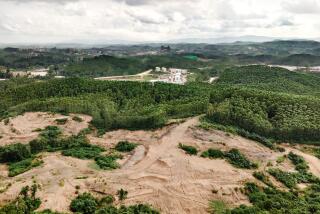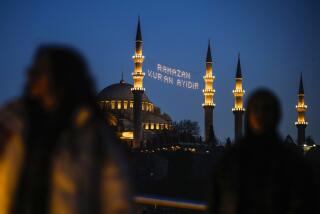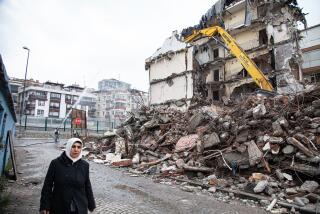Gridlock in ‘Streets Paved With Gold’ : Istanbul’s Old Charms Fading With Pressure of Fast Growth
- Share via
ISTANBUL, Turkey — Perhaps the best panorama of Istanbul is to be seen from the Galata Bridge, a grinding, creaking pontoon structure facing the Straits of Bosporus and spanning the curving inlet known as the Golden Horn.
An early morning mist lends the scene a diffuse quality, as in an aging watercolor, with the city’s architectural jewels--the minarets of the Suleiman Mosque reach up like ballistic missiles--standing out against an indistinct pattern of red-tile roofs.
On the bridge itself, the picture is far closer to the reality of present-day Istanbul: four lanes of automobile and bus traffic stalled in foul-smelling gridlock, as thousands of pedestrians plod stolidly to work. Men with bathroom scales line the sidewalk offering to weigh a passer-by for a coin, while throngs of young boys with huge brass-bound boxes offer shoeshines in reasonably fluent German.
Istanbul is choking on its growth. A saying common in the Anatolian hinterland of Turkey holds that the “streets of Istanbul are paved with gold,” and literally millions of people have trekked from poor rural areas to this, the industrial heart of the country.
“Before World War II, the population was around 800,000 and now there are more than 6 million people,” said Sidney Noel, a Briton who has spent the past 30 years in Istanbul. “The population growth has been a dramatic change, with most of the increase in shantytowns around the city in areas which foreigners never see.”
Cobblestone Streets
In addition to population growth, a Turkish car factory is now producing 100,000 vehicles a year, 40% of which end up in Istanbul, a 19th-Century city of winding cobblestone streets that was never designed to cope with modern traffic. The suspension bridge over the Bosporus, which in 1973 linked the European part of Istanbul with its neighborhoods in Asia for the first time, is now used by 140,000 cars a day. A second bridge is under construction, and traffic in the city is so bad that a third bridge is already being planned.
“Istanbul is losing a lot of its character quite quickly because of overgrowth,” said Felice Ozer, a Vassar-educated architectural historian. “People come here from small villages and want to duplicate the village life style. But there is no infrastructure--sewers, water or telephones.”
In the so-called “triangle” area of the oldest section of European Istanbul, a nighttime population of 400,000 swells to more than 2 million during the day, a phenomenon similar to the downtowns of such other cities as New York and Los Angeles.
Istanbul’s oldest areas have such tiny, winding streets that there is usually room for only one car at a time. Businesses resort to animals--even men and boys are used as beasts of burden--to carry their goods from factories to shops.
Mayor’s Brainchild
In an effort to preserve Istanbul’s grandeur, the city government has embarked on a feverish urban renewal campaign. The plan is primarily the brainchild of Istanbul’s mayor, a dynamic former electrical engineer named Bedrettin Dalan.
Under Dalan’s leadership, the city has been dotted with parking garages, streets have been widened and tracks are being laid for a light rail tram system to ferry thousands of workers 15 miles from central Istanbul to a new industrial suburb at Ikitelli.
Ironically, until the 1960s the city’s primary mode of transportation was the tram, but the tracks were ripped up because the slow trams were considered to be impeding other traffic.
Perhaps Dalan’s most ambitious project is the cleanup of the Golden Horn, a $350-million slum clearance and sewage project whose aim, in the mayor’s oft-quoted pledge, is to make the waters of the Golden Horn “as blue as my eyes.”
6,000 Buildings Bulldozed
By city estimates, bulldozers have razed 6,000 buildings along the edges of the Golden Horn inlet. Most of them were factories and illegal slaughterhouses whose effluents had seriously polluted the water for decades, and most have been replaced by parks and playgrounds.
But Dalan has also raised a storm of controversy by sweeping away many old buildings without any attempt at conservation and with little consultation with the community.
“This new program to make Istanbul better does not take into account the old character of the city,” said Celik Gulersoy, the head of Turkey’s auto club, which has embarked on a restoration campaign of its own in recent years.
Gulersoy noted, for example, that in a single night bulldozers pushed down the 16th-Century building that was built as the Venetian Embassy when that city-republic was a dominant influence in the Mediterranean.
“They have totally changed the face of historic Istanbul,” Gulersoy complained.
Preservation efforts are concentrated now on some of the remaining wooden houses, with their unfinished exteriors and beautiful bay windows. Hundreds of these stunning seaside wooden mansions that gave Istanbul the look of Venice have already disappeared, and now there are few remaining examples of the architectural style.
‘City of Garden Apartments’
“All those houses are gone and have been replaced by apartment buildings,” said Ozer, the architectural historian. “It was a green city of gardens and now it is a city of garden apartments.”
Construction teams also are digging massive tunnels along the Golden Horn for the sewer pipes, which, when completed, will take Istanbul’s sewage out into the Bosporus, to be discharged 200 feet beneath the surface. The hope is that lower-level currents there will sweep the sewage into the Black Sea where it will be dispersed harmlessly. But there is a scientific controversy raging over whether the sewage plan will work.
“We won’t see all the results for a couple of years, but the water is already cleaner,” Ozer said. “The awful smell is gone.”
Despite the controversies, the Golden Horn cleanup and other municipal projects have made Dalan into a nationwide hero. A recent opinion poll placed him ahead of Prime Minister Turgut Ozal, who leads the conservative Motherland Party that Dalan also belongs to.
Despite the many changes, Istanbul remains for the non-resident a trove of 19th-Century European architectural treasures that go almost unnoticed. For example, a building as prosaic as the post office on the Istiklal, Istanbul’s Fifth Avenue, has cut-glass windows, carved wooden doors, marble floors and ornate brass scales on the counters.
Delicate Scrollwork
The facades of many buildings are laced with the delicate scrollwork of 19th-Century Ottoman artisans. Balconies of finely turned iron work are visible even in decaying areas.
In other neighborhoods, the city resembles a rural village, thanks in part to the proliferation of “night houses.” Night houses derive their name from a law under which a house could not legally be pulled down by police if it had two walls and a roof, which could be built during a single night. Amenities were added later.
“You walk a few yards from the central boulevards of Istanbul and you see rural Anatolia, the way people dress and eat and even talk,” said businessman Mehmet Isvan, whose brother was mayor before Dalan.
Along with the burgeoning shantytowns, builders are planning at least five office towers, each more than 45 stories tall, as well as six deluxe hotels to cope with the current tourism boom.
The clash of cultures has helped to intensify Istanbul’s identity crisis, which dates back a century when Turks were torn between identifying with Asia or Europe.
“Istanbul is like the St. Sophia--a great Christian church with minarets,” Ufuk Guldemir, a local journalist, said. “Istanbul has a character all of its own, but it’s not Turkey.”
More to Read
Sign up for Essential California
The most important California stories and recommendations in your inbox every morning.
You may occasionally receive promotional content from the Los Angeles Times.










